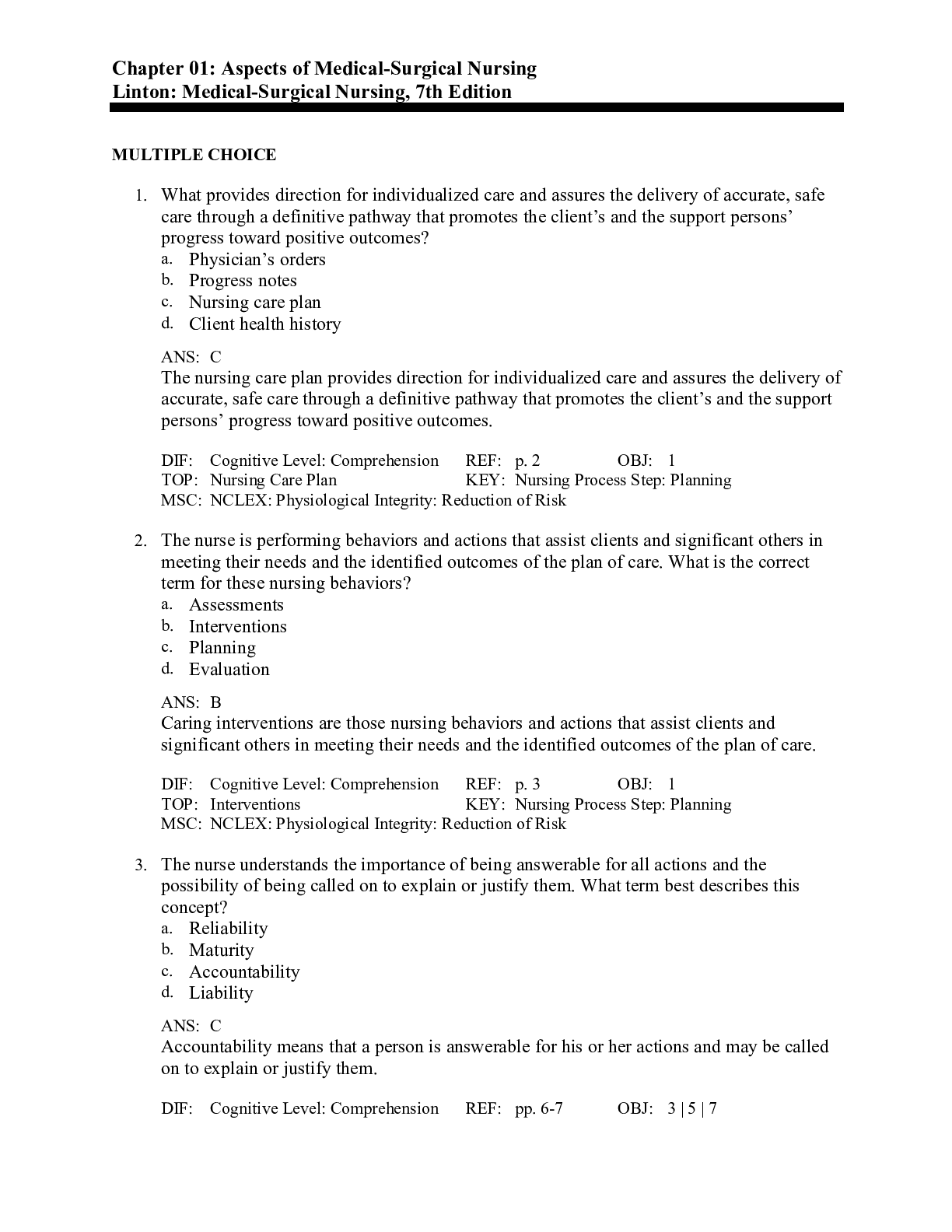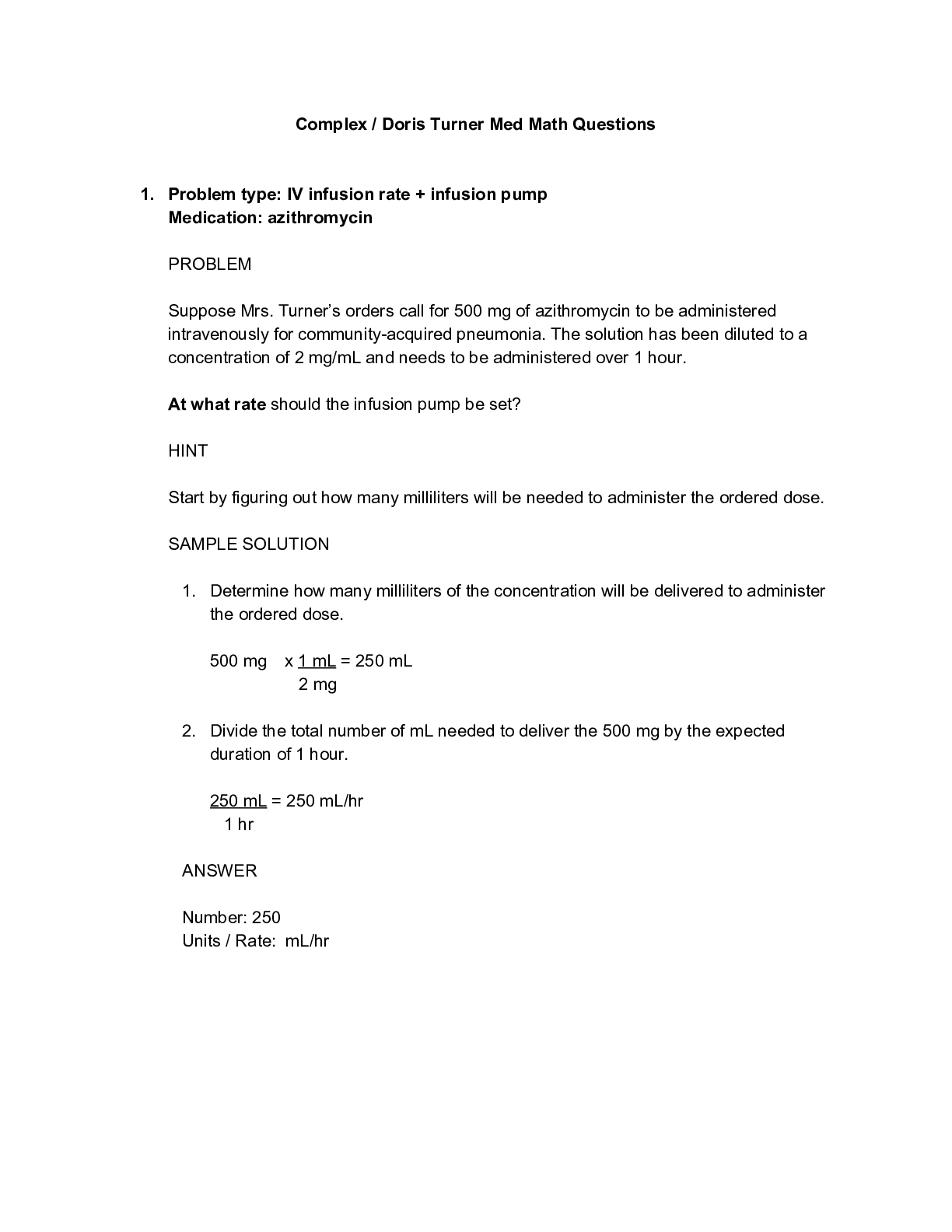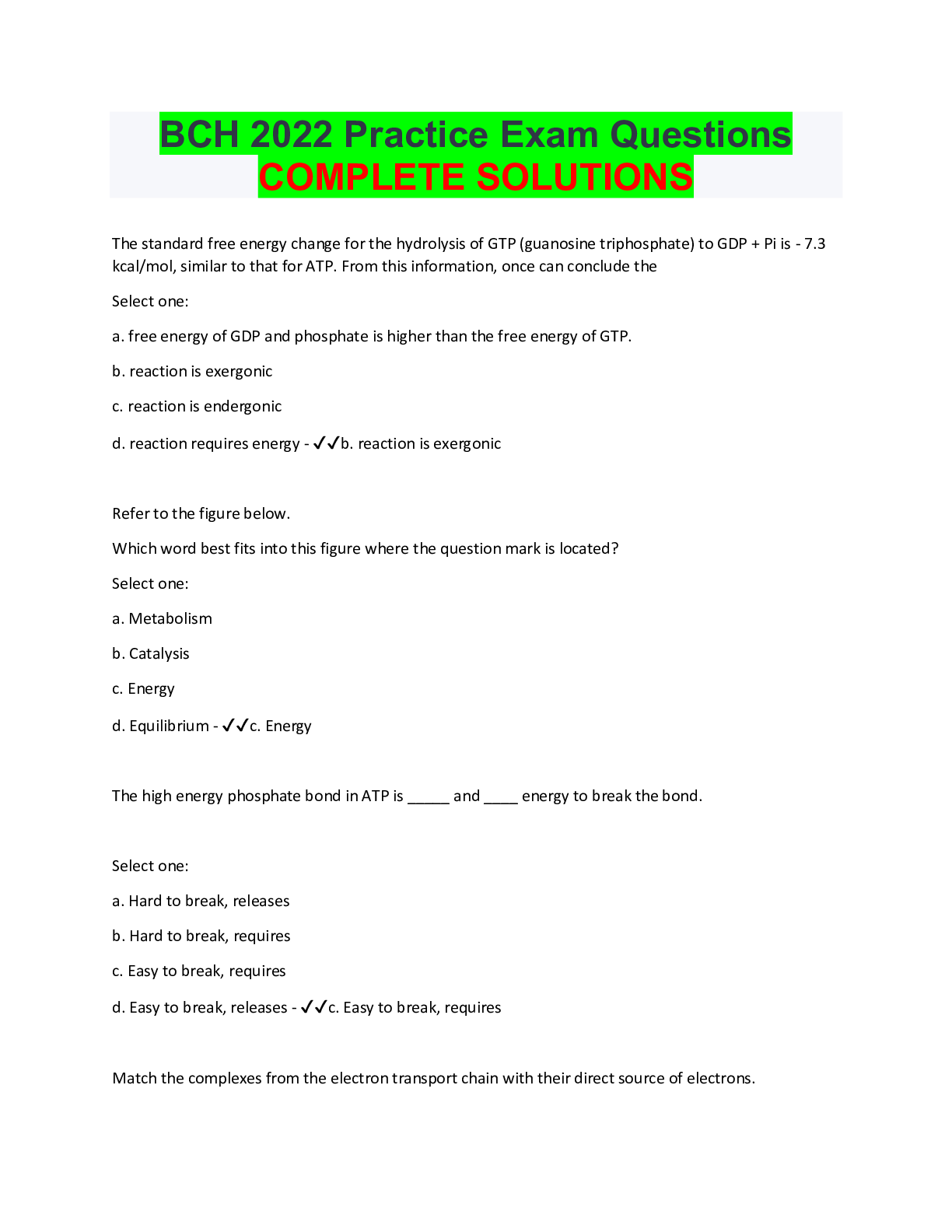Maternity ATI Capstone Practice Questions Complete Solutions
Document Content and Description Below
a nurse concludes that the father of an infant is not showing positive signs of parent‐infant bonding. He appears very anxious and nervous when the infant's mother asks him to bring her the infant... . Which of the following actions should the nurse use to promote father‐infant bonding? a. Hand the father the infant, and suggest that he change the diaper. B. ask the father why he is so anxious and nervous. C. Tell the father that he will grow accustomed to the infant. d. Provide education about infant care when the father is present. Ans- d. CORRECT: nursing interventions to promote paternal bonding include providing education about infant care and encouraging the father to take a hands‐on approach. a client in the early postpartum period is very excited and talkative. She is repeatedly telling the nurse every detail of her labor and birth. Because the client will not stop talking, the nurse is having difficulty completing the postpartum assessments. Which of the following action should the nurse take? a. Come back later when the client is more cooperative. B. Give the client time to express her feelings. C. Tell the client she needs to be quiet so the assessment can be completed. d. redirect the client's focus so that she will become quiet. Ans- B. CORRECT: The nurse should recognize that the client in is the taking‐in phase, which begins immediately following birth and lasts a few hours to a couple of days. a nurse is caring for a client who is 1 day postpartum. The nurse is assessing for maternal adaptation and mother‐infant bonding. Which of the following behaviors by the client indicates a need for the nurse to intervene? (Select all that apply.) a. demonstrates apathy when the infant cries B. Touches the infant and maintains close physical proximity C. Views the infant's behavior as uncooperative during diaper changing d. identifies and relates infant's characteristics to those of family members e. interprets the infant's behavior as meaningful and a way of expressing needs Ans- C. CORRECT: a client's view of her infant as being uncooperative during diaper changing is a sign of impaired maternal‐ infant bonding. a nurse is caring for a client who is 2 days postpartum. The client states, "My 4‐year old son was toilet trained and now he is frequently wetting himself." Which of the following statements should the nurse provide to the client? a. "your son was probably not ready for toilet training and should wear training pants." B. "your son is showing an adverse sibling response." C."your son may need counseling." d."you should try sending your son to preschool to resolve the behavior." Ans- B. CORRECT: adverse responses by a sibling to a new infant can include regression in toileting habits. a nurse in the delivery room is planning to promote maternal‐infant bonding for a client who just delivered. Which of the following is the priority action by the nurse? a. encourage the parents to touch and explore the neonate's features. B. limit noise and interruption in the delivery room. C. Place the neonate at the client's breast. d. Position the neonate skin‐to‐skin on the client's chest. Ans- d. CORRECT: Placing the neonate in the en face position on the client's chest immediately after birth is the priority nursing intervention to promote maternal‐infant bonding. a nurse on the postpartum unit is caring for four clients. Which of the following clients should the nurse recognize as the greatest risk for development of a postpartum infection? a. a client who experienced a precipitous labor less than 3 hr in duration B. a client who had premature rupture of membranes and prolonged labor c. a client who delivered a large for gestational age infant D. a client who had a boggy uterus that was not well‐contracted Ans- B. CORRECT: Premature rupture of membranes with prolonged labor poses the greatest risk for developing a postpartum infection because the birth canal was open, allowing pathogens to enter. A nurse is teaching a client who is breastfeeding and has mastitis. Which of the following responses should the nurse make? a. "Limit the amount of time the infant nurses on each breast." B. "nurse the infant only on the unaffected breast until resolved." c."completely empty each breast at each feeding or use a pump." D."Wear a tight‐fitting bra until lactation has ceased." Ans- c. CORRECT: Instruct the client to completely empty each breast at each feeding to prevent milk stasis, which provides a medium for bacterial growth. a nurse is reviewing discharge teaching with a client who has a urinary tract infection. Which of the following statements by the client indicates understanding of the teaching? (select all that apply.) a. "I will perform peri care and apply a perineal pad in a back‐to‐front direction." B. "I will drink cranberry and prune juices to make my urine more acidic." c."I will drink large amounts of fluids to flush the bacteria from my urinary tract." D."I will go back to breastfeeding after I have finished taking the antibiotic." e. "I will take tylenol for any discomfort." Ans- B. CORRECT: acidification of urine inhibits bacterial multiplication. c. CORRECT: Increased fluid intake can help to flush the bacteria from the urinary tract. e. CORRECT: acetaminophen is taken to reduce discomfort and pain associated with a urinary tract infection. a nurse is caring for a client who has mastitis. Which of the following is the typical causative agent of mastitis? a. Staphylococcus aureus B. Chlamydia trachomatis c. Klebsiella pneumonia D. Clostridium perfringens Ans- a. CORRECT: Staphylococcus aureus, Escherichia coli, and streptococcus are usually the infecting agents that enter the breast due to sore or cracked nipples, which results in mastitis. a nurse is discussing risks factors for urinary tract infections with a newly licensed nurse. Which of the following conditions should the nurse include in the teaching? (select all that apply). a. epidural anesthesia B. urinary bladder catheterization c. frequent pelvic examinations D. History of utIs e. Vaginal birth Ans- a. CORRECT: epidural anesthesia is a risk factor for a utI. B. CORRECT: urinary bladder catheterization is a risk factor for a utI. c. CORRECT: a history of frequent pelvic examinations is a risk factor for a utI. D. CORRECT: a history of utIs is a risk factor for developing utIs. a nurse in a clinic is reviewing the facility's testing process and procedures for human immune deficiency virus (hiv) with a new employee. Which of the following information should the nurse include in the review? a. in the presence of hiv, the enzyme immunoassay (eia) test is typically reactive within 72 hr after the client is infected. B. the Western blot assay is used to confirm diagnosis of hiv. c. the polymerase chain reaction (prc) test is used to confirm diagnosis of hiv. D. cD4+ cell counts will be elevated in a client who is infected with hiv. Ans- B. CORRECT: confirming hiv is a two-step process. if the eia is positive, a second test (the Western blot assay) is done. a nurse is providing instructions to a client prior to her first mammogram. Which of the following information should the nurse provide prior to the procedure? a. "You should not take any aspirin products prior to the mammogram." B. "Do not use apply any deodorant the day of the exam." c."You will need to avoid sexual intercourse the day before the mammogram." D."You should avoid exercise prior to the exam." Ans- B. CORRECT: applying deodorant or powder can alter the accuracy of a mammogram by causing a shadow to appear. a nurse is providing education to a client prior to her first papanicolaou (pap) test. Which of the following statements should the nurse make? a. "You should urinate immediately after the procedure is over." B. "You will not feel any discomfort." c."You may experience some bleeding after the procedure." D."You will need to hold your breath during the procedure." Ans- c. CORRECT: the client can experience a small amount of vaginal bleeding due to scraping of the cervix. a nurse in a provider's office is reviewing a client's laboratory results, which shows a positive rapid plasma regain (rpr). Which of the following tests will be administered to the client to confirm the diagnosis of syphilis? a. venereal Disease research laboratory (vDrl) B. D-dimer c. fluorescent treponemal antibody absorbed (fta-aBs) D. sickledex Ans- c. CORRECT: the fluorescent treponemal antibody absorbed is used to confirm the diagnosis of syphilis. a nurse is providing teaching for a client who is to undergo a cervical biopsy. Which of the following information should the nurse include in the instructions? (select all that apply.) a. "the procedure is painless." B. "avoid heavy lifting for approximately 2 weeks after the procedure." c."heavy bleeding is common during the first 12 hours after the procedure." D."plan to rest for the first 72 hours after the procedure." e. "avoid the use of tampons for 2 weeks after the procedure." Ans- B. CORRECT: the client should avoid heavy lifting until the cervix has healed, which takes approximately 2 weeks. e. CORRECT: the client should not use tampons until the cervix has healed, which takes approximately 2 weeks. A nurse is admitting a client who is in labor and has HIV. Which of the following interventions should the nurse identify as contraindicated for this client? (select all that apply.) A. episiotomy B. oxytocin infusion c. forceps D. cesarean birth e. Internal fetal monitoring Ans- A. CORRECT: An episiotomy should be avoided for a client who is HIV‐ positive due to the risk of maternal blood exposure. c. CORRECT: the use of forceps during delivery should be avoided due to the risk of fetal bleeding. e. CORRECT: Internal fetal monitoring should be avoided due to the risk of fetal bleeding. A nurse in an antepartum clinic is assessing a client who has a toRcH infection. Which of the following findings should the nurse expect? (select all that apply.) A. Joint pain B. Malaise c. Rash D. Urinary frequency e. tender lymph nodes Ans- A. CORRECT: toRcH infections are flu‐like in presentation, such as joint pain. B. CORRECT: toRcH infections are flu‐like in presentation, such as malaise. c. CORRECT: toRcH infections can include findings such as a rash. e. CORRECT: toRcH infections are flu‐like in presentation, such as tender lymph nodes. A nurse is caring for a client who has gonorrhea. Which of the following medications should the nurse anticipate the provider will prescribe? A. ceftriaxone B. fluconazole c. Metronidazole D. Zidovudine Ans- A. CORRECT: ceftriaxone IM or doxycycline orally for 7 days is prescribed for the treatment of gonorrhea. A nurse is caring for a client who is in labor. the nurse should identify that which of the following infections can be treated during labor or immediately following birth? (select all that apply.) A. Gonorrhea B. chlamydia c. HIV D. Group B streptococcus beta‐hemolytic e. toRcH infection Ans- A. CORRECT: erythromycin is administered to the infant immediately following delivery to prevent Neisseria gonorrhoeae. B. CORRECT: erythromycin is administered to the infant immediately following delivery to prevent Chlamydia trachomatis. c. CORRECT: Retrovir is prescribed to a client in labor who is HIV‐positive. D. CORRECT: Penicillin G or ampicillin may be prescribed to treat positive GBs. A nurse manager is reviewing ways to prevent a toRcH infection during pregnancy with a group of newly licensed nurses. Which of the following statements by a nurse indicates understanding of the teaching? A. "obtain an immunization against rubella early in pregnancy." [Show More]
Last updated: 2 years ago
Preview 1 out of 28 pages
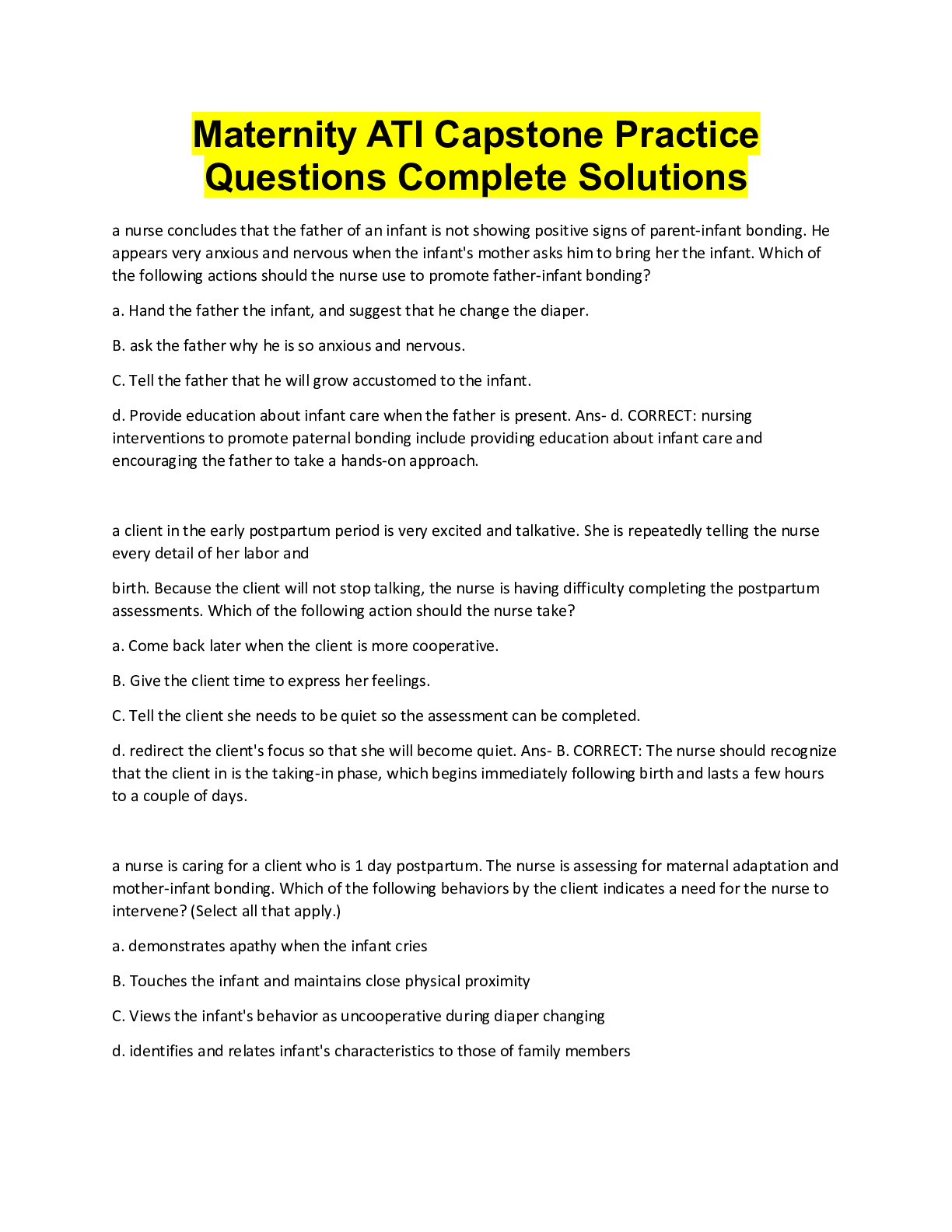
Buy this document to get the full access instantly
Instant Download Access after purchase
Buy NowInstant download
We Accept:

Reviews( 0 )
$9.00
Can't find what you want? Try our AI powered Search
Document information
Connected school, study & course
About the document
Uploaded On
Feb 12, 2023
Number of pages
28
Written in
Additional information
This document has been written for:
Uploaded
Feb 12, 2023
Downloads
0
Views
89

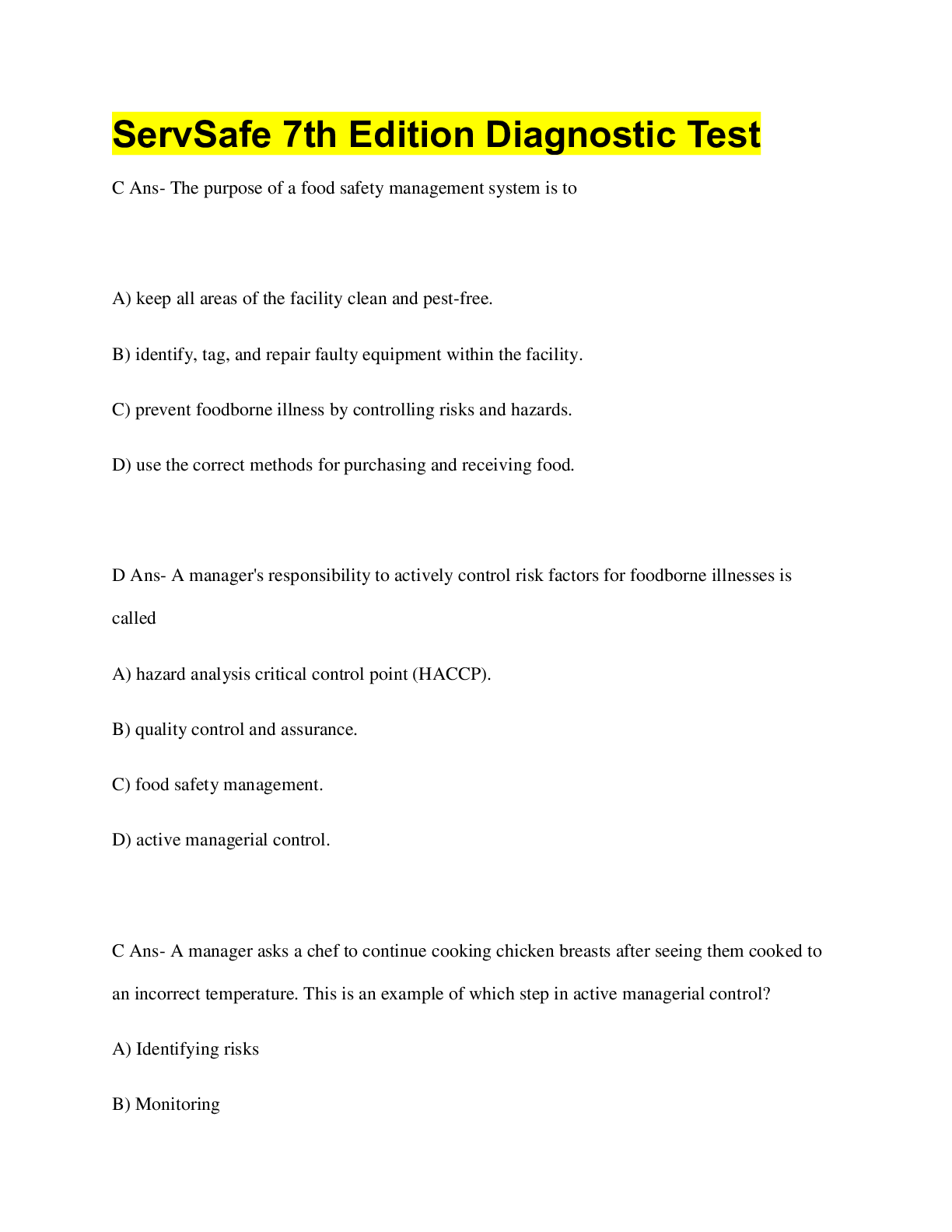


.png)
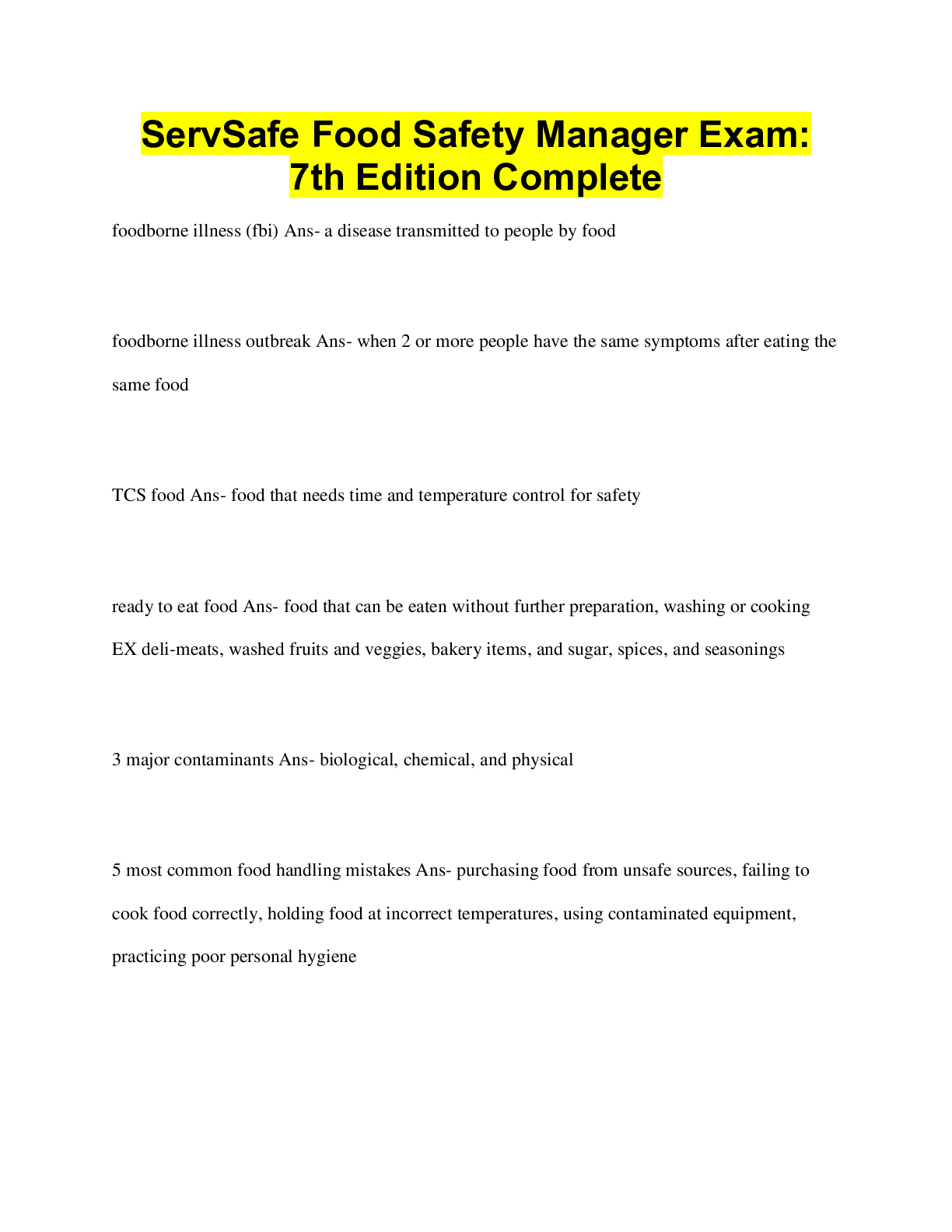
.png)

